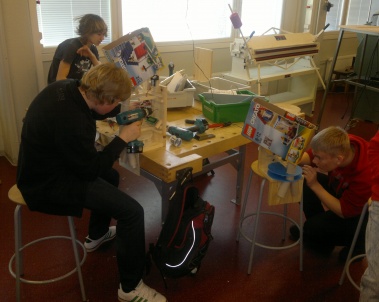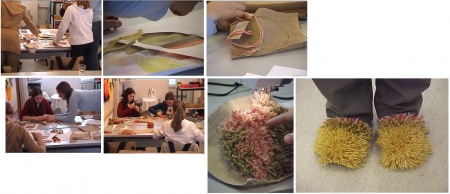Craft education in Finnish comprehensive schools
Description
Crafts is a common subject for everyone in grades 1–7 of comprehensive school and an optional subject in grades 8–9. Many upper secondary schools have courses aiming towards a general upper secondary school diploma in crafts. In basic education, crafts are taught to all pupils, which guarantees an internationally unique opportunity to maintain and develop the craft tradition. Craft teachers are trained at universities to pass on and develop the tradition through their own teaching.
Craft education is being studied and developed continuously. New information and new practices keep the tradition vital and able to renew itself.
Implementing new contents and goals requires both physical resources and time. The number of hours allocated for craft education have diminished, which is a cause for concern with regard to creating a sufficient foundation of skill and knowledge.

The best experts of craft education are the teachers teaching crafts at comprehensive schools, i.e. the class teachers and the crafts subject teachers. They are highly trained experts in their work, with a university-level Master’s degree.
The university-level expertise in craft education in Finland is concentrated in the University of Helsinki, the University of Turku, the University of Eastern Finland, and Åbo Akademi. They have established their own crafts disciplines: craft science, craft education, or pedagogy of crafts (‘slöjdpedagogik’), and they organise craft teacher training. Academic research on crafts and craft education has been carried out in Finland since the early 1980s, and dozens of doctoral theses on the subject have been completed as well as hundreds of master's thesis. Comprehensive school pupils, both current and former, are also important experts in craft education and practitioners of the craft tradition. In addition to other important things, all children and young people study crafts while completing their compulsory education.
Background
Crafts has been one of the subjects in compulsory general education throughout its history, since the mid-1800s. At the time, the general opinion in Finland was that knowledge of religious, moral and social norms, reading and writing skills and basic mathematics were important. Furthermore, the basic skills of a citizen in a society (that was becoming modern and industrialised) also included skills related to crafts, professional work, agriculture and gardening. These last were important because people needed to be able to cope with practical everyday problems and live an active and thrifty life. It can be said that the contents and goals of crafts as a subject originally originated from the agrarian society.
At the beginning, there were separate crafts subjects for girls and boys, called female and male crafts, or as they were known later, girls’ and boys’ crafts. After the transition into comprehensive school that started from the 1970s, the subject has been called textile work and technical work. From the mid-1990s, the comprehensive school has only had one crafts subject that is studied by everyone and simply called ‘crafts’. Crafts is a common subject to everyone, and it is taught by using many different materials and a large variety of techniques.

Even though the history of craft education in Finland is long, it is not a historical remnant; it is a living tradition that changes and develops with the times in many ways. The objectives and contents of craft education have changed from a product-centred approach emphasising the everyday needs of home, practicality and economy, into a process-centred approach emphasising educational values. For example, the industrious, thorough effort and meticulous technical performance that characterised the early days of studying crafts has given way in the modern school to bold ideas and playful experimentation by the pupils, with the aim of finding joy in making things and developing problem-solving skills. Developing design and expression skills is a key objective that is promoted both individually and through shared projects. The cultural and social meanings of crafts are studied equally with crafts processes.
The skills of using modern technology and cultural perspective have also gained increasing attention in craft education. Craft education aims to meet the challenges of today without forgetting the importance of maintaining and developing the tradition, both on the level of individuals, as well as local and global culture. The educational importance of crafts is found especially in that it helps people to develop all of the aspects of their personality equally. This is due to producing crafts being a multifaceted process, which includes creating product ideas, visual and technical design, and manufacturing and assessment. The goal of craft education is that the pupils slowly gain the mastery of an entire crafts production process. Then they both develop in diverse ways and gain pleasure in their work, while taking responsibility for the quality of their work.
A key goal in craft education is to make the pupils ecologically and ethically aware. Because learning crafts takes a great deal of practice and it is a very slow process, the pupils have time to become familiar with the materials they are working with. With the knowledge of materials gained through personal experience, they learn to understand and respect materials, which in turn promotes the development of ecological ethics. It is clear that these greater goals cannot be completely reached during basic education within the small number of hours allocated for them, but it is possible to sow the seeds of good development at crafts lessons.
Passing on the tradition of craft education to the future generations and developing it are still mainly the responsibility of craft teachers, teacher educators and researchers in the field. They pass on the tradition not only in their work, but also as culturally influential people in their home areas and the whole nation. The international cooperation carried out by teachers and researchers is also an important factor in this respect.
One important channel for craft education is the association Käsityö verkossa ry. At the core of its activities is the Punomo.fi/teeitse website and the network linked to it. The Punomo.fi/teeitse website is an extensive site for craft instructions and ideas realised by professionals in the field, through which traditions and new ideas are transmitted to school crafts. The website has been active since 1996. The Punomo.fi network also includes the craft blogs by teachers, schools and teaching groups, through which tradition is passed on.
Future
Crafts as a subject has maintained its position among the subjects in general basic education, and it is also a part of optional studies in many upper secondary schools. Crafts is a school subject that is important and loved by many pupils, and it combines learning both skills and knowledge. Craft education has been able to develop and meet the challenges of each era, and it offers excellent possibilities as a part of multidisciplinary modules connecting different subjects, both in basic education and in upper secondary schools. The future of the craft education tradition seems bright, but the reduction in the number of hours allocated to it at schools is a cause for concern. The challenge is to implement increasingly diverse and topical goals with fewer lesson hours available.
The community/communities behind the submission
Behind this submission is a group of craft teachers and researchers: Seija Kojonkoski-Rännäli, Sirpa Kokko, Tarja Kröger, Sinikka Pöllänen, Riikka Räisänen, Erja Syrjäläinen.
Bibliography and links to external sources of information
Kotilainen, S. & Simpanen, M.-R. 2003. Suomalaisen käsityökoulutuksen vaiheita 1700-luvulta 2000-luvulle. Jyväskylä: Suomen käsityön museon julkaisuja 22.
Marjanen, P. 2012. Koulukäsityö vuosina 1866–2003. Kodin hyvinvointiin kasvattavista tavoitteista kohti elämänhallinnantaitoja. Publications of the University of Turku. Series C. Part 344.
Perkkiö, V. & Tuikkala, K. 2014. Käsityönopetus Suomessa 2030. Skenaarioita peruskoulun käsityönopetuksen tulevaisuudesta. University of Eastern Finland. Philosophical Faculty, School of Applied Educational Science and Teacher Education. Master’s thesis in Craft Science.
Paajanen, R. & Rastas, J. 2010. Koulukäsityö 2040 – Asiantuntijoiden näkemyksiä koulukäsityön tulevaisuuden opetuksen perustekijöistä. University of Turku. Faculty of Education, Department of Teacher Education. Master’s thesis in Craft Education.
Simpanen, M.-R. 2003. Lyhyt oppimäärä koulukäsityöhön. Jyväskylä: The Craft Museum of Finland.
Tuomaala, S. 2004. Työtätekevistä käsistä puhtaiksi ja kirjoittaviksi. Suomalaisen oppivelvollisuuskoulun ja maalaisten kohtaaminen 1921–1939. Bibliotheca historica 89. The Finnish Literature Society (SKS). Helsinki: Hakapaino.
